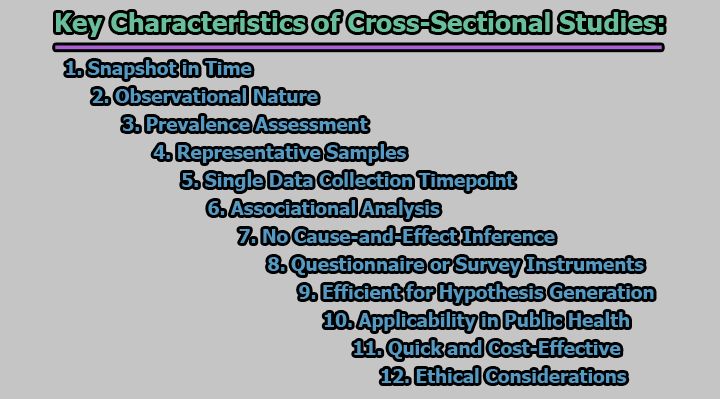Cross-sectional studies serve as invaluable tools in the realm of research, offering a swift and cost-effective means of capturing a snapshot of a population’s characteristics, behaviors, and conditions at a specific moment in time. This observational design, akin to taking a photograph, allows researchers to explore associations between variables and assess prevalence without the need for extensive temporal commitments. In this article, we are going to know about cross-sectional studies, key characteristics of cross-sectional studies, advantages and disadvantages of cross-sectional studies.
Definitions of Cross-sectional Studies:
A cross-sectional study can be likened to a snapshot captured in the vast realm of scientific inquiry. In the clinical researcher’s lens, it serves as a frozen moment in time, meticulously examining a diverse group of participants to unveil patterns, associations, or prevalence of a particular condition. This methodology is akin to peering through a multidimensional window, offering a simultaneous glimpse into the health status, behaviors, and characteristics of a population without delving into the intricacies of cause and effect. Much like a skilled photographer framing a compelling shot, the cross-sectional study captures a comprehensive view, offering valuable insights into the snapshot of health within a community (Clinical Researcher’s Perspective).
From the perspective of an epidemiologist, a cross-sectional study functions as a wide-angle lens capturing the panoramic landscape of disease distribution within a population. This observational method allows the epidemiologist to discern not only the prevalence of a particular health outcome but also to explore potential risk factors or protective elements. It is akin to creating a topographical map of health patterns, essential for understanding the terrain of diseases and devising strategies for intervention. In this approach, the cross-sectional study is a strategic tool for sketching the epidemiological contours of a population, providing critical insights into the current health scenario (Epidemiologist’s Lens).
For the statistical analyst, a cross-sectional study resembles a comprehensive survey, akin to taking a representative cross-section of society and analyzing the collected data to discern underlying trends. It is akin to scrutinizing a mosaic of information, where each participant contributes a unique piece to the larger puzzle. From this perspective, the study design facilitates the application of statistical techniques to unravel associations, correlations, and disparities within the dataset. Much like a mathematician solving a complex equation, the statistical analyst navigates through the intricacies of data points, extracting meaningful patterns that contribute to our understanding of the studied phenomena (Statistical Analyst’s View).
In the realm of public health, a cross-sectional study can be seen as a diagnostic tool, providing a comprehensive health check-up for a community. Just as a physician conducts routine examinations to assess a patient’s overall well-being, the public health practitioner utilizes this study design to gauge the health status and potential risk factors prevalent in a population. It is an invaluable lens through which public health interventions can be tailored, addressing the identified health concerns and promoting the overall well-being of the community. In essence, the cross-sectional study serves as a compass guiding public health initiatives toward the most pressing health issues within a given population (Public Health Practitioner’s Insight).
Key Characteristics of Cross-Sectional Studies:
Cross-sectional studies are a type of observational research design that aims to collect data from participants at a single point in time to examine the relationship between variables of interest. Here are key characteristics of cross-sectional studies:
1. Snapshot in Time: Cross-sectional studies capture a single moment in the continuum of time. Imagine freezing a frame in a movie to closely examine the details within that still shot—that’s the essence of a cross-sectional study. Researchers choose a specific point or a short timeframe to collect data from participants. This temporal snapshot allows them to gain a comprehensive understanding of the distribution of variables of interest at that particular moment. However, it’s important to note that this static perspective limits the ability to discern how variables might change over time.
2. Observational Nature: Cross-sectional studies are fundamentally observational, emphasizing the collection and analysis of data without any experimental manipulation. In contrast to experimental designs where researchers actively intervene and control variables, observers in cross-sectional studies remain passive. They do not introduce changes or treatments to study participants but instead focus on documenting and understanding the existing characteristics, behaviors, or conditions within the chosen population. This observational approach enhances the study’s ecological validity by reflecting real-world scenarios.
3. Prevalence Assessment: One primary goal of cross-sectional studies is to assess the prevalence of a particular outcome or condition within the chosen population. Prevalence refers to the proportion of individuals in a population who have a specific characteristic or condition at a given point in time. For example, in a health-related cross-sectional study, researchers may determine the prevalence of a certain disease, risk factor, or health behavior. This prevalence estimation is crucial for understanding the public health landscape, guiding resource allocation, and informing intervention strategies. The study’s findings contribute valuable insights into the frequency and distribution of key variables within the studied population.
4. Representative Samples: Ensuring that the sample selected for the study is representative of the larger population is a critical aspect of cross-sectional research. Researchers aim to create a sample that mirrors the demographics, characteristics, and relevant traits of the broader population under investigation. A representative sample enhances the external validity of the study, allowing for more confident generalizations of the findings to the entire population. This involves employing random sampling techniques or carefully selecting participants to avoid biases that could skew the results and compromise the study’s validity.
5. Single Data Collection Timepoint: Cross-sectional studies emphasize efficiency by collecting data at a single timepoint. This design choice distinguishes cross-sectional studies from longitudinal studies, where data is gathered over an extended period. The simplicity of a one-time data collection process makes cross-sectional studies more time-efficient and cost-effective. However, this characteristic also limits the ability to establish temporal relationships or causation between variables since researchers cannot track changes or developments over time. Despite this limitation, the approach is advantageous when a quick, snapshot view of the population is sufficient for the research objectives.
6. Associational Analysis: Cross-sectional studies are well-suited for exploring associations or relationships between variables within the collected data. By analyzing the data at the chosen timepoint, researchers can identify correlations, trends, or patterns among different variables of interest. Statistical methods such as correlation coefficients or chi-square tests may be employed to quantify the strength and direction of these associations. While these analyses reveal valuable insights into potential relationships, it’s crucial to recognize that correlation does not imply causation. Establishing cause-and-effect relationships typically requires more in-depth, longitudinal investigations that can uncover the temporal sequence of events.
7. No Cause-and-Effect Inference: One significant limitation of cross-sectional studies is the inability to establish cause-and-effect relationships between variables. Since the data is collected at a single point in time, researchers cannot determine the temporal sequence of events. While cross-sectional studies are excellent for identifying associations and patterns, they do not provide the necessary evidence to infer causation. Establishing causation requires longitudinal studies or experimental designs that can demonstrate a clear cause-and-effect relationship by manipulating variables and observing their effects over time.
8. Questionnaire or Survey Instruments: Data collection in cross-sectional studies often involves the use of structured questionnaires, interviews, or surveys. These instruments are designed to gather information on various aspects of participants’ demographics, behaviors, attitudes, or health conditions. The use of standardized questionnaires allows for consistency in data collection, making it easier to analyze and compare results across different study participants. However, it’s crucial to carefully design these instruments to ensure they capture relevant information accurately and reliably.
9. Efficient for Hypothesis Generation: Cross-sectional studies play a crucial role in the early stages of scientific inquiry by serving as efficient tools for hypothesis generation. By identifying associations between variables, researchers can formulate hypotheses that can then be tested in more rigorous study designs. These studies act as a starting point, guiding researchers toward specific areas of interest and informing the development of more in-depth, longitudinal investigations. The efficiency and relatively lower cost of cross-sectional studies make them valuable for exploring new research avenues and refining research questions before committing to more resource-intensive studies.
10. Applicability in Public Health: Cross-sectional studies find extensive application in public health research. They are particularly valuable for assessing the prevalence of health conditions, risk factors, and health behaviors within specific populations. Public health practitioners use cross-sectional data to understand the health status of communities, identify key issues, and plan targeted interventions. The results can inform health policies, resource allocation, and public health campaigns, contributing to the overall improvement of community well-being.
11. Quick and Cost-Effective: The simplicity of the cross-sectional study design contributes to its efficiency, making it a quick and cost-effective research method. Gathering data at a single timepoint reduces the time and resources required for the study compared to longitudinal designs. This characteristic is advantageous in situations where timely information is crucial, or when budgetary constraints limit the feasibility of more elaborate research approaches.
12. Ethical Considerations: Cross-sectional studies must adhere to ethical standards to ensure the well-being and rights of study participants. Researchers are obligated to obtain informed consent from participants, clearly explaining the study’s purpose, procedures, and potential risks. Ethical review boards play a crucial role in evaluating the study design to ensure it prioritizes participant safety and confidentiality. Respecting ethical guidelines is paramount in maintaining the integrity of the research and safeguarding the welfare of those contributing to the study.
Example of Cross-Sectional Study:
Let’s consider an example of a cross-sectional study in the field of public health:
Title: “Prevalence of Smoking Among Urban Adults: A Cross-Sectional Analysis”
Objective: To determine the prevalence of smoking and explore associated factors among adults residing in an urban community.
Study Design: This cross-sectional study involved the collection of data from a representative sample of urban adults aged 18 to 65 years. The researchers aimed to capture a snapshot of smoking habits, demographics, and potential correlates in the urban population.
Sampling Method: A stratified random sampling approach was employed to ensure representation across different age groups, genders, and socioeconomic statuses within the urban community. The researchers randomly selected participants from diverse neighborhoods to create a sample reflective of the overall urban adult population.
Data Collection: Structured interviews were conducted using a standardized questionnaire. The questionnaire covered various aspects, including smoking habits (current, former, or never-smoker), frequency of smoking, duration of smoking, exposure to secondhand smoke, socioeconomic status, education level, and awareness of smoking-related health risks.
Analysis: Descriptive statistics were used to calculate the prevalence of smoking in the urban adult population. Additionally, inferential statistics such as chi-square tests and logistic regression were applied to explore associations between smoking and demographic variables, socioeconomic factors, and awareness of health risks.
Findings: The study found that out of the sampled urban adults, 20% were current smokers, 15% were former smokers, and 65% had never smoked. The prevalence of smoking was higher among males, individuals with lower educational attainment, and those with lower socioeconomic status. Additionally, the study identified a correlation between smoking prevalence and awareness of health risks associated with smoking.
Implications: The cross-sectional study provided valuable insights into the prevalence and correlates of smoking in the urban adult population. These findings can inform public health interventions, educational campaigns, and policy initiatives aimed at reducing smoking rates and addressing specific risk factors within the urban community.
Use Cases of Cross-Sectional Study:
Cross-sectional studies find applications across various disciplines due to their versatility and efficiency in capturing a snapshot of a population at a specific point in time. Here are some common use cases of cross-sectional studies:
a. Disease Prevalence and Risk Factors: In epidemiology and public health, cross-sectional studies are frequently used to assess the prevalence of diseases within a specific population and identify associated risk factors. For example, a cross-sectional study may examine the prevalence of diabetes in an urban community and explore potential risk factors such as diet, physical activity, and family history.
b. Health Behavior and Lifestyle Patterns: Researchers use cross-sectional studies to investigate health behaviors and lifestyle patterns. This includes studying factors such as smoking, alcohol consumption, physical activity, and dietary habits. Understanding these behaviors is crucial for designing targeted health promotion programs and interventions.
c. Psychological Research: In psychology, cross-sectional studies are employed to examine the prevalence of psychological conditions or behaviors within a specific group. For instance, a study might investigate the prevalence of anxiety or depression in a college student population and explore associated factors like academic stress or social support.
d. Educational Research: Cross-sectional studies can be utilized in education research to understand various aspects of the educational system. Researchers might investigate the prevalence of learning disabilities among students in a specific grade or explore the correlation between socioeconomic status and academic achievement.
e. Market Research: In business and marketing, cross-sectional studies are used to gather insights into consumer behaviors, preferences, and market trends at a particular point in time. For example, a study might examine the prevalence of smartphone usage and preferences among a specific demographic group.
f. Sociological Studies: Sociologists use cross-sectional studies to explore social phenomena and trends within a population. This could include studying the prevalence of certain social attitudes, cultural practices, or the distribution of socioeconomic factors across different demographic groups.
g. Political Science: Cross-sectional studies can be applied in political science to analyze voter preferences, political participation, or the prevalence of specific political beliefs within a region. This type of research provides a snapshot of the political landscape at a given moment.
h. Employee Satisfaction and Workplace Studies: Human resources and organizational psychologists may conduct cross-sectional studies to assess employee satisfaction levels, work-related stress, or the prevalence of certain workplace practices. This information can inform organizational policies and interventions to improve workplace well-being.
i. Community Development Studies: Cross-sectional studies are valuable in community development research to assess the current state of communities. This might include studying the prevalence of poverty, access to essential services, and community engagement levels to inform development initiatives.
j. Technology Adoption and Usage: In the field of technology, researchers may use cross-sectional studies to understand the prevalence of technology adoption and usage patterns among different demographics. For example, a study might investigate the prevalence of smartphone ownership and usage among elderly populations.
Advantages of Cross-Sectional Studies:
- Cross-sectional studies are efficient and cost-effective, providing a quick snapshot of a population’s characteristics without the need for long-term data collection.
- Compared to longitudinal studies, cross-sectional designs require fewer resources, making them more feasible for researchers with limited budgets and time constraints.
- These studies are valuable for generating hypotheses, helping researchers identify potential associations between variables that can be explored in more in-depth investigations.
- The one-time data collection allows for the simultaneous examination of various factors, providing a convenient way to assess the prevalence of conditions or behaviors.
- Cross-sectional studies offer valuable data for public health planning by assessing the prevalence of health conditions and identifying priority areas for intervention.
- Researchers can obtain results relatively quickly, making cross-sectional studies suitable for situations where timely information is essential for decision-making.
- Researchers can compare different subgroups within the population simultaneously, enabling the identification of disparities or variations in the prevalence of variables.
- For rare conditions, cross-sectional studies may be more practical than longitudinal approaches, providing a sufficient sample size to study uncommon outcomes.
- These studies provide a baseline understanding of the distribution of variables, setting the stage for future research and longitudinal investigations.
- Cross-sectional studies are versatile and applicable across various disciplines, allowing researchers to address a wide range of research questions efficiently.
Disadvantages of Cross-Sectional Studies:
- Cross-sectional studies cannot establish causation as they observe variables at a single point, lacking the temporal sequencing necessary for causal relationships.
- The simultaneous data collection fails to provide information on the temporal order of events, hindering the determination of whether exposure precedes the outcome.
- Cross-sectional studies are primarily concerned with determining prevalence, offering limited insights into the changes of variables over time.
- The study’s accuracy is compromised when there is selection bias, where the sample does not truly represent the broader population.
- As momentary snapshots, cross-sectional studies may not capture fluctuations or seasonal variations in variables, limiting the understanding of dynamic trends.
- These studies may overlook individuals who experienced the outcome of interest and are no longer part of the population due to recovery or mortality.
- Studying rare conditions is challenging as the prevalence may not be adequately represented in the sample, affecting the study’s generalizability.
- Relying on participant recall in surveys may introduce bias, especially when assessing past behaviors or exposures.
- Cross-sectional studies are not designed to measure incidence rates, making it challenging to determine the risk of developing a specific condition over time.
- For populations with rapid changes or transient characteristics, the cross-sectional approach may not capture the full spectrum of variability, leading to an incomplete understanding of population dynamics.
In conclusion, cross-sectional studies offer a valuable lens through which researchers can glean insights into the multifaceted aspects of populations. Their efficiency, versatility, and ability to generate hypotheses make them essential in diverse fields, from public health to psychology and beyond. While the benefits of this study design are evident, it is imperative to approach the findings with caution, recognizing the limitations that accompany a snapshot approach. As we navigate the landscape of research methodologies, the cross-sectional study stands as a powerful tool, providing a foundation for further exploration and understanding within the dynamic tapestry of human behaviors, health, and societal dynamics.
References:
- Babbie, E. R. (2016). The Practice of Social Research. Cengage Learning.
- Bordens, K. S., & Abbott, B. B. (2014). Research Design and Methods: A Process Approach. McGraw-Hill Education.
- Bryman, A. (2016). Social research methods. Oxford University Press.
- Creswell, J. W., & Creswell, J. D. (2017). Research Design: Qualitative, Quantitative, and Mixed Methods Approaches. Sage Publications.
- Fortin, M. (2003). The use of the Delphi method in a research project examining information systems success. The Delphi Method: Techniques and Applications, 18, 29-46.
- Gordis, L. (2014). Epidemiology. Elsevier.
- Hertzog, C., & Nesselroade, J. R. (2003). Assessing psychological change in adulthood: An overview of methodological issues. Psychology and Aging, 18(4), 639–657. https://doi.org/10.1037/0882-7974.18.4.639
- Nachmias, D., & Nachmias, C. (2008). Research Methods in the Social Sciences. Worth Publishers.
- Nachimuthu, N., Haerian, B. S., Tan, J. H., & Aziz, S. (2019). The Delphi method as a research tool: An example, design considerations and applications. Information & Management, 56(7), 103-160.
- Neuman, W. L. (2014). Social Research Methods: Qualitative and Quantitative Approaches. Pearson.
- Szklo, M., & Nieto, F. J. (2018). Epidemiology: Beyond the basics. Jones & Bartlett Learning.

Assistant Teacher at Zinzira Pir Mohammad Pilot School and College










